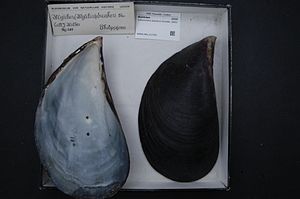Crenomytilus grayanus
| Crenomytilus grayanus | ||||||||||||
|---|---|---|---|---|---|---|---|---|---|---|---|---|

Crenomytilus grayanus |
||||||||||||
| Systematics | ||||||||||||
|
||||||||||||
| Scientific name | ||||||||||||
| Crenomytilus grayanus | ||||||||||||
| ( Dunker , 1853) |
Crenomytilus grayanus is the only species of the genus Crenomytilus within the family of mussels (Mytilidae). Like many other mussel species that live in relatively cold waters, Crenomytilus grayanus growsvery slowly and can get very old. Mussels of this type were found over 126 years old.
features
The equally-folded, moderately bulbous housing is oblique-egg-shaped ( mytiliform ), and is up to about 14 centimeters long. It is strongly asymmetrical, the vertebrae are close to the front end. The dorsal margin is only slightly arched, the ventral margin is almost straight to slightly concave. The vertebral area is very tightly rounded and forms a "hook". The rear end is well rounded. The lock has a tooth in the right flap and a corresponding pit in the left flap.
The ligament is sunk into a pit and sits on a compact elongated back; it is covered by the periostracum. The inner edge is finely notched. The anterior sphincter is small, but it is strong compared to other species. The retractor muscle is elongated and sits behind the vertebra. The very large posterior sphincter is rounded and connected to the retraction muscle; this virtually forms a worm-shaped extension.
The peel is thick and firm and continues to strengthen from the inside as it ages. The ornamentation consists of concentric growth strips and ridges. The periostracum is reddish-brown, very shiny and easily flakes off.
Similar species
The species differs from the other genera and species of mussels (Mytilidae) by the serrated inner edge, the compact back on which the ligament sits and the comparatively strong anterior sphincter muscle.
Geographical distribution, habitat and way of life
Crenomytilus grayanus occurs from the Sea of Okhotsk and the Kuriles to Japan and the Liancourt rocks between South Korea and Japan.
The mussels live subtidally in shallow water and are often found in masses that are attached to their base in clusters. They form a dominant species of some biocenoses in these waters.
Taxonomy
The taxon was set up in 1853 by Wilhelm Dunker in the form Mytilus grayanus . It is the type species and also the only recent species of the genus Crenomytilus Soot-Ryen, 1955. However, the genus is not monotypical, namely, Soot-Ryen still lists four fossil species that belong to the genus Crenomytilus . The oldest species, Crenomytilus mathewsoni (Gabb, 1866) comes from the Oligocene .
Individual evidence
- ↑ a b N.I. Selin, PA Dulenina: The Growth and Lifespan of the Mussel Crenomytilus grayanus (Bivalvia: Mytilidae) in the Tatar Strait (Sea of Japan) in Connection with the Conditions of Life at the Northern Border of the Species Range. Russian Journal of Marine Biology, 38 (4): 318-324, 2012 doi : 10.1134 / S1063074012040074
- ↑ Min Ho Son, Byung Kyu Hong, Sung Yun Hong, Kyeong Am Jeon, Chang Ho Moon: Report of Twenty Five Additional Molluscan Species from Rocky Inter- and Subtidal Area of Dokdo Island, Korea. Korean Journal of Malacology, 20 (2): 135-140, 2004 PDF
- ↑ William Dunker: New Mytilaceen. Zeitschrift für Malakozoologie, 10 (5): 82-92, Cassel / Kassel 1853 www.biodiversitylibrary.org (p. 84).
- ^ Tron Soot-Ryen: A report on the family Mytilidae (Pelecypoda). Allan Hancock Pacific Expeditions, 20 (1): 1-176, Los Angeles 1955 Online at USC Digital Library
- ↑ MolluscaBase: Crenomytilus grayanus (Dunker, 1853)